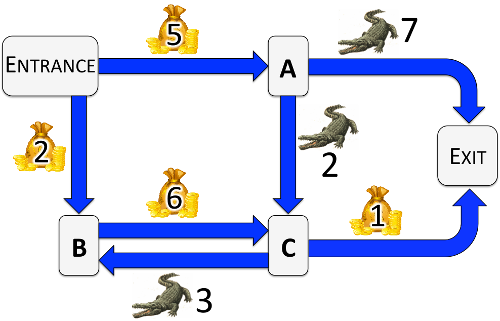

Dirk’s next challenge is a risky game. The game consists in walking through a maze of (one way) corridors, connecting small rooms. Players enter the maze through the Entrance room and leave it from another room, the Exit. At the Entrance, they receive an unlimited credit card with zero balance and have no gold coins.
In each corridor there is:
The amount of coins in a bag or required to lower a bridge varies depending on the corridor. Every time a player walks the same corridor, he finds himself in the same situation: either there is always a bag containing the same number of gold coins, or there is always a raised bridge, which is lowered with the same amount of gold coins. No corridor has both a bag and a bridge.
Each corridor has an arrow painted on the floor indicating the direction in which players are allowed to move. Backtracking is strictly prohibited. The game ends as soon as the player arrives at the Exit (which is reachable from any room). At that moment, it is seen if the player is in the money (won gold coins) or still owes money on his credit card.
In spite of his anxiety, Dirk has already decided to enter the game. Since he is fond of the number 3, immediately before entering the maze, he asked the organization if he could lose money even if he arrived at the Exit having passed through at most 3 (not necessarily distinct) corridors.
Could you answer that question? It can be tricky!
Notice that Entrance → B → C → B → C → Exit is a way to arrive at the Exit passing through 5 corridors.
Given the number N Dirk is fond of and a maze description, the goal is to find out the correct answer to Dirk’s question: Can he lose money even if he arrives at the Exit having passed through at most N (not necessarily distinct) corridors?
The first line of the input has three integers: N, R, and C. N is the number Dirk is fond of, R is the number of rooms, and C is the number of corridors. Rooms are identified by integers, ranging from 0 to R−1. The Entrance is room 0 and the Exit is room R−1.
Each of the following C lines contains two different integers, r1 and r2, the letter B or the letter C, and an integer G. The first two numbers indicate that there is a corridor from room r1 to room r2. If the letter is B, the corridor has a bag with G gold coins. If the letter is C, the corridor has crocodiles and the drawbridge is lowered with G gold coins. It is guaranteed that no corridor starts at the Exit (that is, r1 ≠ R−1).
The output has a single line with the answer to Dirk’s question. The answer is impossible when Dirk cannot arrive at the Exit passing through at most N (not necessarily distinct) corridors. The answer is yes when Dirk can arrive at the Exit passing through at most N (not necessarily distinct) corridors and there is a way of doing that in which he loses money. The answer is no in all other cases.
| 1 ≤ N ≤ 5 000 | The number Dirk is fond of. |
| 2 ≤ R ≤ 5 000 | Number of rooms. |
| 1 ≤ C ≤ 50 000 | Number of corridors. |
| 1 ≤ G ≤ 100 | Number of gold coins in a bag or required to lower a bridge. |
3 5 7 1 4 C 7 0 1 B 5 0 2 B 2 1 3 C 2 2 3 B 6 3 2 C 3 3 4 B 1
yes
3 5 7 1 4 C 5 0 1 B 5 0 2 B 2 1 3 C 2 2 3 B 6 3 2 C 3 3 4 B 1
no
1 5 7 1 4 C 7 0 1 B 5 0 2 B 2 1 3 C 2 2 3 B 6 3 2 C 3 3 4 B 1
impossible
This document was translated from LATEX by HEVEA.